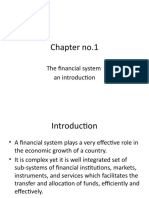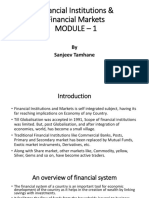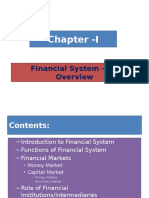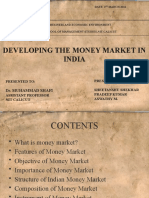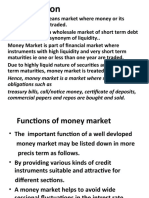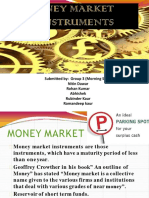0 ratings0% found this document useful (0 votes)
38 viewsFinancial System: - An Institutional Framework Existing in A Country To Enable Financial Transactions - Three Main Parts
Financial System: - An Institutional Framework Existing in A Country To Enable Financial Transactions - Three Main Parts
Uploaded by
Omkarpratim MitraThe financial system consists of financial assets, institutions, and markets. It enables funds to flow from surplus units to deficit units through various instruments for savers like deposits and for borrowers like loans. Key financial institutions that mobilize savings include banks, insurance companies, and mutual funds. Money markets are for short-term funds and include instruments like treasury bills, commercial paper, and certificates of deposit. Capital markets are for long-term funds and include primary stock and bond markets.
Copyright:
© All Rights Reserved
Available Formats
Download as PPTX, PDF, TXT or read online from Scribd
Financial System: - An Institutional Framework Existing in A Country To Enable Financial Transactions - Three Main Parts
Financial System: - An Institutional Framework Existing in A Country To Enable Financial Transactions - Three Main Parts
Uploaded by
Omkarpratim Mitra0 ratings0% found this document useful (0 votes)
38 views10 pagesThe financial system consists of financial assets, institutions, and markets. It enables funds to flow from surplus units to deficit units through various instruments for savers like deposits and for borrowers like loans. Key financial institutions that mobilize savings include banks, insurance companies, and mutual funds. Money markets are for short-term funds and include instruments like treasury bills, commercial paper, and certificates of deposit. Capital markets are for long-term funds and include primary stock and bond markets.
Original Description:
Financial System
Original Title
Financial System
Copyright
© © All Rights Reserved
Available Formats
PPTX, PDF, TXT or read online from Scribd
Share this document
Did you find this document useful?
Is this content inappropriate?
The financial system consists of financial assets, institutions, and markets. It enables funds to flow from surplus units to deficit units through various instruments for savers like deposits and for borrowers like loans. Key financial institutions that mobilize savings include banks, insurance companies, and mutual funds. Money markets are for short-term funds and include instruments like treasury bills, commercial paper, and certificates of deposit. Capital markets are for long-term funds and include primary stock and bond markets.
Copyright:
© All Rights Reserved
Available Formats
Download as PPTX, PDF, TXT or read online from Scribd
Download as pptx, pdf, or txt
0 ratings0% found this document useful (0 votes)
38 views10 pagesFinancial System: - An Institutional Framework Existing in A Country To Enable Financial Transactions - Three Main Parts
Financial System: - An Institutional Framework Existing in A Country To Enable Financial Transactions - Three Main Parts
Uploaded by
Omkarpratim MitraThe financial system consists of financial assets, institutions, and markets. It enables funds to flow from surplus units to deficit units through various instruments for savers like deposits and for borrowers like loans. Key financial institutions that mobilize savings include banks, insurance companies, and mutual funds. Money markets are for short-term funds and include instruments like treasury bills, commercial paper, and certificates of deposit. Capital markets are for long-term funds and include primary stock and bond markets.
Copyright:
© All Rights Reserved
Available Formats
Download as PPTX, PDF, TXT or read online from Scribd
Download as pptx, pdf, or txt
You are on page 1of 10
Financial System
An institutional framework existing in a
country to enable financial transactions
Three main parts
Financial assets (loans, deposits, bonds, equities,
etc.)
Financial institutions (banks, mutual funds,
insurance companies, etc.)
Financial markets (money market, capital market,
forex market, etc.)
Regulation is another aspect of the financial
system (RBI, SEBI, IRDA, FMC)
Financial assets/instruments
Enable channelising funds from surplus units
to deficit units
There are instruments for savers such as
deposits, equities, mutual fund units, etc.
There are instruments for borrowers such as
loans, overdrafts, etc.
Like businesses governments too raise funds
through issuing of bonds, Treasury bills, etc.
Instruments like PPF, KVP, etc. are available
to savers who wish to lend money to the
government
Money Market Instruments
Call money- money borrowed/lent for a day.
No collateral is required.
Inter-bank term money- Borrowings among
banks for a period of more than 14 days
Treasury Bills- short term instruments issued
by the Union Govt. to raise money. Issued at a
discount to the face value
Certificates of Deposit- Issued by banks to
raise money. Minimum value is Rs. 1 lakh,
tradable in the market
CDs can be issued by banks/FIs
Money Market Instruments
(2)
Commercial Paper (CPs) are issued by
corporates to raise short term money
Issued in multiple of 25 lakhs, can be
issued by companies with a net worth of
at least 5 crores
CP is an unsecured promissory note
privately placed with investors at a
discount rate to face value. The maturity
of CP is between 3 and 6 months
Financial Institutions
Includes institutions and mechanisms
which
Affect generation of savings by the
community
Mobilisation of savings
Effective distribution of savings
Institutions are banks, insurance
companies, mutual funds-
promote/mobilise savings
Individual investors, industrial and
Financial Markets
Money Market- for short-term funds
(less than a year)
Organised (Banks)
Unorganised (money lenders, chit funds,
etc.)
Capital Market- for long-term funds
Primary Issues Market
Stock Market
Bond Market
Organised Money Market
Call money market
Bill Market
Treasury bills
Commercial bills
Bank loans (short-term)
Organised money market comprises
RBI, banks (commercial and co-
operative)
Call money market (1)
It deals with one-day loans (overnight, to be
precise) called call loans or call money
Participants are mostly banks. Also called
inter-bank call money market.
The borrowing is exclusively limited to banks,
who are temporarily short of funds.
On the lending side, besides banks with
excess cash and as special cases few FIs like
LIC, UTI
All others have to keep their funds in term
deposits of minimum 15 days with banks to
earn interest
Call money market (2)
Call loans are generally made on a clean
basis- i.e. no collateral is required
The main function of the call money market is
to redistribute the pool of day-to-day surplus
funds of banks among other banks in
temporary deficit of funds
The call market helps banks economise their
cash and yet improve their liquidity
It is a highly competitive and sensitive market
It acts as a good indicator of the liquidity
position
Bill Market
Treasury Bill market- Also called the T-Bill
market
These bills are short-term liabilities (91-day, 182-
day, 364-day) of the Government of India
It is an IOU of the government, a promise to pay the
stated amount after expiry of the stated period
from the date of issue
They are issued at discount to the face value and at
the end of maturity the face value is paid
The rate of discount and the corresponding issue
price are determined at each auction
Commercial Bill market- Not as developed in
India as the T-Bill market
You might also like
- Fee Structures in Private Equity Real Estate.Document31 pagesFee Structures in Private Equity Real Estate.miguelrevillaNo ratings yet
- 1-A Company Which Owns The Stock of Three Different BanksDocument5 pages1-A Company Which Owns The Stock of Three Different BanksalikahdNo ratings yet
- Overview of Indian Financial SystemDocument25 pagesOverview of Indian Financial SystemDr. Meghna DangiNo ratings yet
- Indian Financial SystemDocument53 pagesIndian Financial SystemSiddharth BansalNo ratings yet
- Chapter No.1: The Financial System An IntroductionDocument19 pagesChapter No.1: The Financial System An IntroductionChavda BhaveshNo ratings yet
- Indian Fixed Income MarketDocument27 pagesIndian Fixed Income MarketNitesh GoyalNo ratings yet
- Unit 1Document64 pagesUnit 1Suneel KumarNo ratings yet
- Constituents of The Financial System DD Intro NewDocument17 pagesConstituents of The Financial System DD Intro NewAnonymous bf1cFDuepPNo ratings yet
- IFS 2023-24-newDocument48 pagesIFS 2023-24-newnehasp1503No ratings yet
- Money Market: Dr. Divya Asst. Prof., USMS, GGSIPUDocument27 pagesMoney Market: Dr. Divya Asst. Prof., USMS, GGSIPUHarsh PrakashNo ratings yet
- Indian Financial Markets: Class of MBADocument43 pagesIndian Financial Markets: Class of MBAaksid1No ratings yet
- CH 2 Indian Financial SystemDocument46 pagesCH 2 Indian Financial Systemmaheshbendigeri5945No ratings yet
- Finance Specilization: Asst. Professors, MBA Department, Bhagawan Mahavir College of Management, SuratDocument85 pagesFinance Specilization: Asst. Professors, MBA Department, Bhagawan Mahavir College of Management, Suratpravesh malikNo ratings yet
- Management of Financial Services: Finance SpecilizationDocument83 pagesManagement of Financial Services: Finance SpecilizationaamirankNo ratings yet
- FM - Indian Financial SystemDocument70 pagesFM - Indian Financial SystemRubal GangulyNo ratings yet
- Institutional FinanaceDocument29 pagesInstitutional Finanaceradhika77799No ratings yet
- FMBODocument10 pagesFMBOHimani ChavanNo ratings yet
- Money MarketDocument27 pagesMoney MarketThe State AcademyNo ratings yet
- MGMT 102 - Module - 3Document13 pagesMGMT 102 - Module - 3shubhangiverma2005No ratings yet
- IBE Module 6Document29 pagesIBE Module 6Prathik_Shetty_204No ratings yet
- Indian Financial SystemDocument17 pagesIndian Financial SystemMohsin KhanNo ratings yet
- Abhishek Chaudhary Jatinder Dangwal Nupur Jain Ravinder Sharma Rishi Panwar Sakshi Chauhan Shashi Kumar Shankar Narayan BatabyalDocument41 pagesAbhishek Chaudhary Jatinder Dangwal Nupur Jain Ravinder Sharma Rishi Panwar Sakshi Chauhan Shashi Kumar Shankar Narayan BatabyalSakshi ChauhanNo ratings yet
- Financial Institutions & Financial Markets Module - 1: by Sanjeev TamhaneDocument35 pagesFinancial Institutions & Financial Markets Module - 1: by Sanjeev TamhaneSwagatJagtapNo ratings yet
- Finance Specilization: Asst. Professors, MBA Department, Bhagawan Mahavir College of Management, SuratDocument85 pagesFinance Specilization: Asst. Professors, MBA Department, Bhagawan Mahavir College of Management, Suratsakshirelan87No ratings yet
- CH 2 Indian Financial SystemDocument46 pagesCH 2 Indian Financial SystemAkshay AhirNo ratings yet
- Indian Financial SystemDocument40 pagesIndian Financial SystemArun SarkarNo ratings yet
- Indian Financial System Chapter 1Document16 pagesIndian Financial System Chapter 1Rahul GhosaleNo ratings yet
- Understanding - Money MarketDocument39 pagesUnderstanding - Money MarketaartipujariNo ratings yet
- Money Market and Its InstrumentsDocument22 pagesMoney Market and Its InstrumentsRajat SinghNo ratings yet
- An Overview of Indian Financial SystemDocument17 pagesAn Overview of Indian Financial SystemArun DasNo ratings yet
- Money Market's InstrumentsDocument20 pagesMoney Market's InstrumentsManmohan Prasad RauniyarNo ratings yet
- Chapter - I: Financial System - AnDocument33 pagesChapter - I: Financial System - AnSuresh VaddeNo ratings yet
- Summer Placement at IFCDocument20 pagesSummer Placement at IFCCrazytoonagainNo ratings yet
- Money MarketDocument22 pagesMoney Marketkunaldaga78No ratings yet
- Financial Services ManagementDocument43 pagesFinancial Services ManagementChandan ParsadNo ratings yet
- Indianfinancialsystem 120211233627 Phpapp02Document57 pagesIndianfinancialsystem 120211233627 Phpapp02lalitNo ratings yet
- Study Material On Money MarketDocument25 pagesStudy Material On Money MarketPrateek VyasNo ratings yet
- Dr. Vibhuti TripathiDocument39 pagesDr. Vibhuti TripathiforevermukeshNo ratings yet
- Indian Financial SystemDocument42 pagesIndian Financial SystemPunam Dandekar SalviNo ratings yet
- Financial Markets in IndiaDocument15 pagesFinancial Markets in IndiaVjay VijjuNo ratings yet
- Indian Financial SystemDocument39 pagesIndian Financial Systempoojaguptainida1No ratings yet
- Class 1-Indian Financial SystemDocument47 pagesClass 1-Indian Financial SystembitturajaNo ratings yet
- Developing The Money Market in India: Dr. Muhammad ShafiDocument40 pagesDeveloping The Money Market in India: Dr. Muhammad ShafiPradeep KumarNo ratings yet
- Financial System: An Institutional Framework Existing in A Country To Enable Financial Transactions Three Main PartsDocument23 pagesFinancial System: An Institutional Framework Existing in A Country To Enable Financial Transactions Three Main PartsManas MishraNo ratings yet
- Money Market by MostafaDocument28 pagesMoney Market by Mostafamostafaali123No ratings yet
- International Financial System-4Document8 pagesInternational Financial System-4mayurikhale20No ratings yet
- Money MarketDocument25 pagesMoney MarketVaidyanathan RavichandranNo ratings yet
- Financial MarketDocument5 pagesFinancial MarketJignesh VallappilekandyNo ratings yet
- 2 - Money MarketDocument15 pages2 - Money MarketSrijan RajNo ratings yet
- Presented By: Divya Sharma M.B.A. Iv-Sem JietsomgDocument30 pagesPresented By: Divya Sharma M.B.A. Iv-Sem Jietsomglakshmimadhu2005No ratings yet
- Research Assignment of FmiDocument11 pagesResearch Assignment of FmiAnshita GargNo ratings yet
- Unit 5Document97 pagesUnit 5Pankaj PrasadNo ratings yet
- Money Market: Security Analysis and Portfolio ManagementDocument23 pagesMoney Market: Security Analysis and Portfolio Managementrahu007einstein56uNo ratings yet
- Money Market by TanishaDocument15 pagesMoney Market by TanishakirtikaNo ratings yet
- Financial Markets in IndiaDocument26 pagesFinancial Markets in Indiatadpelliwar_navinNo ratings yet
- Mgt-205: Financial Markets and InstitutionsDocument78 pagesMgt-205: Financial Markets and InstitutionsBishal ShresthaNo ratings yet
- 87097-19840-Money MarketDocument8 pages87097-19840-Money MarketVicky HatwalNo ratings yet
- FALLSEM2020-21 CCA2705 TH VL2020210101345 Reference Material III 14-Jul-2020 FINANCIAL MARKETS Module 2 5Document40 pagesFALLSEM2020-21 CCA2705 TH VL2020210101345 Reference Material III 14-Jul-2020 FINANCIAL MARKETS Module 2 5Jayagokul SaravananNo ratings yet
- Money Market Simplified Easy PowerpointDocument17 pagesMoney Market Simplified Easy PowerpointNitin DawarNo ratings yet
- CFA level 1: 2025 Equity Investments: CFA level 1, #2From EverandCFA level 1: 2025 Equity Investments: CFA level 1, #2Rating: 5 out of 5 stars5/5 (1)
- Kami Export - Short StoryDocument2 pagesKami Export - Short StorySama NazimiNo ratings yet
- SIP Report NavkarDocument63 pagesSIP Report Navkarsaundarya.m2003No ratings yet
- Kotler mm14 ch14 DPPTDocument33 pagesKotler mm14 ch14 DPPTMerylle Shayne GustiloNo ratings yet
- Integrated Treasury in A BankDocument7 pagesIntegrated Treasury in A BankKrishi JainNo ratings yet
- One Mark ProductDocument7 pagesOne Mark ProductnidharafNo ratings yet
- MODULE 1-AdvertisingDocument22 pagesMODULE 1-Advertisingleslie_jetNo ratings yet
- Intermediate Accounting Questions PDFDocument4 pagesIntermediate Accounting Questions PDFmaria evangelistaNo ratings yet
- Pivot Com CandleDocument57 pagesPivot Com Candlefgaluppo100% (8)
- Measuring The Markets With PivotsDocument4 pagesMeasuring The Markets With PivotsPaul CarissimoNo ratings yet
- in Our View,: Vrddhi Capital Investment AdvisorsDocument5 pagesin Our View,: Vrddhi Capital Investment AdvisorsMohit AgarwalNo ratings yet
- Mercury Athletic Footwear: Ashutosh DashDocument49 pagesMercury Athletic Footwear: Ashutosh DashSaurabh ChhabraNo ratings yet
- 3 - 1-Asset Liability Management PDFDocument26 pages3 - 1-Asset Liability Management PDFjayaNo ratings yet
- BBFH308 - International Finance Assignment 1Document5 pagesBBFH308 - International Finance Assignment 1Simba MashiriNo ratings yet
- Multiple Choice: - ComputationalDocument4 pagesMultiple Choice: - ComputationalCarlo ParasNo ratings yet
- Sales Management - Part IDocument225 pagesSales Management - Part ITirth DaveNo ratings yet
- Remember Share Key Points MR Gautam Baid Lyst1314Document2 pagesRemember Share Key Points MR Gautam Baid Lyst1314Prateek VaishNo ratings yet
- Interest Rate Risk Management-1Document4 pagesInterest Rate Risk Management-1tmpvd6gw8fNo ratings yet
- Financial Markets AND Financial Services: Chapter-31Document7 pagesFinancial Markets AND Financial Services: Chapter-31Dipali DavdaNo ratings yet
- Netflix Price Table All Country 03/24Document2 pagesNetflix Price Table All Country 03/24SpennacchioneNo ratings yet
- Modigliani and Modigliani Measure - M2 - PortfolioDocument15 pagesModigliani and Modigliani Measure - M2 - PortfolioVaidyanathan RavichandranNo ratings yet
- Digital Marketing Class Notes Mid SemDocument62 pagesDigital Marketing Class Notes Mid SemJai KumarNo ratings yet
- The Economics of Money, Banking and Financial Markets, 13th Global Edition (Frederic Mishkin) (Z-Library)-98-109Document12 pagesThe Economics of Money, Banking and Financial Markets, 13th Global Edition (Frederic Mishkin) (Z-Library)-98-109trithanh.vu1908No ratings yet
- Unioniank: Unionbank Plal.A Meralco An!Nue Onyx Sapphire Roads, Onigas CenlerDocument7 pagesUnioniank: Unionbank Plal.A Meralco An!Nue Onyx Sapphire Roads, Onigas CenlerEdgar LayNo ratings yet
- Accounting p2 Sep 2021Document17 pagesAccounting p2 Sep 2021afrika.entshoNo ratings yet
- CHAPTER1Document50 pagesCHAPTER1Sharayu BavkarNo ratings yet
- Capital Adequacy Ratio For Banks - 1Document9 pagesCapital Adequacy Ratio For Banks - 1Jignesh NayakNo ratings yet
- SIE Practice Exam Questions With Verified Correct AnswersDocument7 pagesSIE Practice Exam Questions With Verified Correct AnswersgichaucarenNo ratings yet
- Options Probability Calculator: Step OneDocument8 pagesOptions Probability Calculator: Step OneDebayan Sen0% (1)




